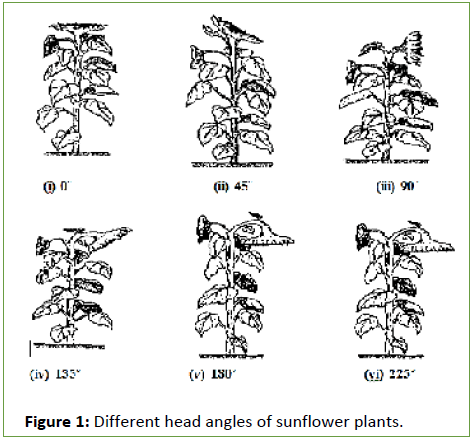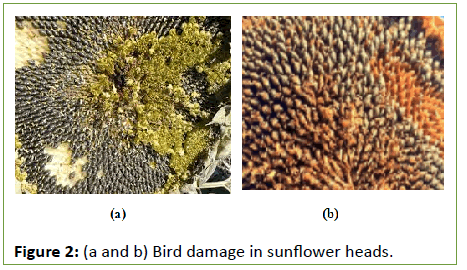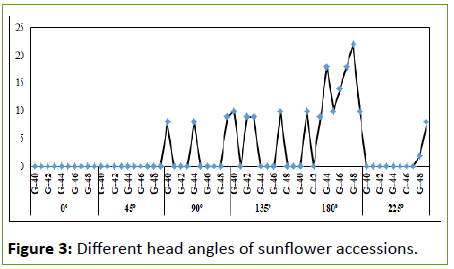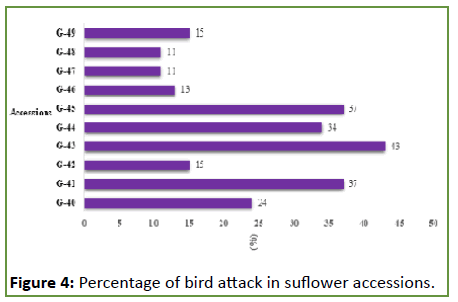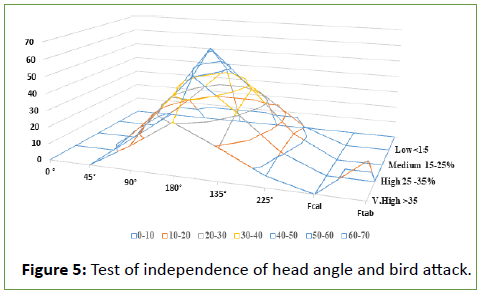Chi-Square Analysis to Test the Dependency for Head Angle and Bird Damage in Sunflower (Helianthus annuus L)
Hina Saleem1*, Muhammad Hammad Nadeem Tahir2 and Humera Razzaq1
1Department of Plant Breeding and Genetics, University of Agriculture, Faisalabad, Pakistan
2Institute of Plant Breeding and Biotechnology, Muhammad Nawaz Shareef University of Agriculture, Multan
- *Corresponding Author:
- Dr. Hina Saleem
Department of Plant Breeding and Genetics,
University of Agriculture,
Faisalabad,
Pakistan,
Tel: +923344444525;
Email: hinah3099@gmail.com
Received Date:August 06, 2021 Accepted Date: August 18, 2021 Published Date:August 25, 2021
Citation: Saleem H, Tahir MHN, Razzaq H (2021) Chi-Square Analysis to Test the Dependency for Head Angle and Bird Damage in Sunflower (Helianthus annuus L). J Res Plant Pathol Vol: 4 No: 4:03.
Abstract
Ten accessions of sunflower were evaluated for achene yield and its related traits. The experiment was laid out following a randomized complete block design with three replications Chi-square analysis was carried to test the dependency for head angle and bird damage. Head angle had a statistically significant effect on bird feeding the sunflower and this trend was for greater bird damage with larger head angles. The results indicated that bird damage and head angle is correlated to each other. Head angle of most of the damaged heads of studied accessions were 180â°. It was observed that the accessions having more percentage of damage (G-43, G-41 and G-45) had more number of plants with head angle 135â° and 180â° as compared to other accessions under observation rather than the upright angles of 45â° or 90â°.
Keywords
Sunflower; Bird damage; Accessions; Fatty acids
Introduction
It possesses the most desirable character of high percentage of linoleic acid as compared to other oilseed crops. This crop is gaining an important position at national and global level. It can successfully be grown under different agro-climatic condition of Pakistan. It occupies an important position among oilseed crop of the world as its production has multiplied by approximately 1.8 times during the last 20 years.
Sunflower seed contains 55-68% oil. Its oil is premium due to its good taste, high smoke point, and dietary quality, lack of linolenic acid and high level of unsaturated fatty acids. Its oil is also enriched with vitamin A, D, E and K and is free from any type of toxic elements. It is also a great source of phosphorus, nicotinic acid and calcium. One hundred pounds of the sunflower achene contains 35% of high protein meal. So it can also be used as livestock feed and birdseed etc. Being drought tolerant it is well suited for irrigated as well as rain fed areas. Its oil is considered as good quality oil from health point of view, due to presence of polyunsaturated fatty acids which are known to reduce the risk of cardiac related problems. Its oil is very stable as it has lesser degree of hydrogenation when kept for long period for storage. It is a short duration crop (95-120 days) so it fits well in any cropping pattern in Pakistan. It holds great importance and has tremendous position because of its photoinsensitivity and wider adaptability. It is not season bound unlike other oilseed crops and can be grown twice a year. Additionally, its oil can be utilized as raw material for manufacturing biodiesel; it is arousing the interest for agriculture professionals, farmers and companies in the world.
But unfortunately, sunflower yield as compared to the other countries in the world is low and one of the major factors regarding it is bird attack. Bird attack on sunflower (Helianthus annuus L.) is a serious problem in many areas where the crop is grown commercially Sunflower is high in carbohydrates and fats thus mostly birds relies on it for their nutrition. The most important birds that attach sunflower in Pakistan are Crow and parrots. A head angle of 180⁰ i.e. the head parallel to the soil surface is highly desirable as it prevents sun scald in the places where temperature is high and during the maturing of achenes, as well as it reduces the bird predation. Therefore to check the dependency of bird attack and head angle the present investigation was undertaken to verify these observations and to study other morphological characteristics and their relationship to bird damage.
Materials and Methods
Experimental conditions
The experiment was carried out in the research area of the Department of Plant Breeding and Genetics, University of Agriculture, Faisalabad during the spring of 2016. Geographical coordinates of Faisalabad are the rolling flat plains of North-East Punjab, between longitude 73˚74 East, latitude 30˚315 North with an elevation of 184 meters above sea level. While average temperature in summer ranges from 30˚C-45˚C and during winter the average temperature falls between 6˚C-17˚C. Monthly average temperature and rainfall during the research period are presented respectively [1-5].
Experimental material
The germplasm consisted of 10 sunflower genotypes G-40, G-41, G-42, G-43, G-44, G-45, G-46, G-47, G-48, G-49 were developed and maintained by the Oilseed Research Group, Department of Plant Breeding and Genetics, University of Agriculture, Faisalabad.
Experimental layout
The experiment was laid out on 17th February 2016 in a Randomized Complete Block Design with three replications. Row to row and plant to plant distance was kept 0.75 m and 0.25 m respectively. One orw ofe ach accession per replication was planted. Length of each row was kept 3.6 m. A total of 4 numbers of irrigations were applied. Cultural practices were performed at times when required in all the experimental units evenly. Fertilizers were applied at different stages of the crop to maintain proper growth. One bag of urea and DAP per hectare were applied at the time of sowing. At the time of flowering one more bag of urea was applied.
Data recording
Ten plants of each accession were taken randomly from each replication and data were recorded on head angle and bird attack.
Head angles
Head angle was measured for all the tagged plants of each accession per replication. Geometrical tool of D shape was used for measurement of head angle. Angle in sunflower head varies from 0˚, 45˚, 90˚, 135˚, 180˚ and 225˚ (Figure 1).
Bird attack
Bird attack damage was measured by using the visual method, in which two flexible cross wires were used. A crossed wire was used which was marked at every 2 cm. Heads of each accession per replication were placed on the table and wire was put over the head which divided the head in quarters [6-8].
Then the damage was measured in each section considering every section as 25% of the total. Figure 1 shows measurement for bird attack. Then data were polled to calculate the bird damage. Bird damage is shown in Figure 1 (i) and (ii). The measurement for bird attack is shown in Figure 1 (iii). The same procedure was performed for the heads of all genotypes per replications (Figure 2).Bird attack was measured using the scores:
1) Very high>35%
2) High 25-35%
3) Medium 15%-25%
4) Low<15%.
Results
Head angle
Figure 3 represents the head angle in sunflower accessions. Head angles of 0⁰ and 45⁰ were not observed in any accession of sunflower. Whereas, more than twenty plants of eight accessions had head angle of 180⁰.
The accession G-48 had maximum plants with 180⁰ head angle. Accessions G-48 and G-49 had more than four plants with head angle of 225⁰. Eighty plants of G-40 and G-44 and nine plants of G-49 had head angle of 90⁰. Accessions G-40, G-42, G-43 and G-47 had ten, nine, nine and ten plants respectively with head angle of 135⁰.
Bird damage
Figure 4 percentage of bird damage is shown in different sunflower accessions. Minimum bird damage was observed in accessions G-47 (11%) and G-48 (11%). Accessions G-43 (43%) followed by G-41 (37%) and G-45 (37%) had maximum bird damage (Figures 3-5) (Table 1).
| 0⁰ | 45⁰ | 90⁰ | 180⁰ | 135⁰ | 225⁰ | Fcal | Ftab |
|
|---|---|---|---|---|---|---|---|---|
| V.High> 35 | - | - | 14.39 | 30.78 | 19.19 | 6.62 | 348.09NS | 21.7 |
| High25%-35% | - | - | 23.52 | 50.29 | 31.36 | 10.81 | ||
| Medium15%-25% | - | - | 28.79 | 61.56 | 38.39 | 13.24 | ||
| <15 | - | - | 20.27 | 43.35 | 27.03 | 9.32 |
Table 1: Test of independence of head angle and bird attack.
Discussion
Test of independence of bird damage and head angle
Chi-square analysis was carried to test the dependency for head angle and bird damage. The above table indicates that there is no independence present between both traits. Head angle had a statistically significant effect on bird feeding the sunflower and this trend was for greater bird damage with larger head angles. The results indicated that bird damage and head angle is correlated to each other. Head angle of most of the damaged heads of studied accessions were 180⁰. It was observed that the accessions having more percentage of damage (G-43, G-41 and G-45) had more number of plants with head angle 135⁰ and 180⁰ as compared to other accessions under observation rather than the upright angles of 45⁰ or 90⁰ [9,10].
Conclusion
Chi-square analysis was carried to test the dependency for head angle and bird damage. The results indicated that there is no independence present between both traits. Thus bird damage and head angle are correlated to each other. Head angle of most of the damaged heads of studied accessions were 180⁰. It was observed that the accessions having more percentage of bird damage (G-43, G-41 and G-45) had more number of plants with head angle of 135⁰ and 180⁰ as compared to other accessions under observation. Its oil is considered as good quality oil from health point of view, due to presence of polyunsaturated fatty acids which are known to reduce the risk of cardiac related problems. Its oil is very stable as it has lesser degree of hydrogenation when kept for long period for storage. It is a short duration crop (95-120 days) so it fits well in any cropping pattern in Pakistan. It holds great importance and has tremendous position because of its photo-insensitivity and wider adaptability. It is not season bound unlike other oilseed crops and can be grown twice a year. Additionally, its oil can be utilized as raw material for manufacturing biodiesel; it is arousing the interest for agriculture professionals, farmers and companies in the world.
References
- Aslam S, Khan S, Saleem M, Qureshi, Khan A, et al. (2010) Heterosis for the improvement of oil quality in sunflower (Helianthus annuus L.). Pak J Bot 42(2): 1003-1008.
- Bullard, Roger W. (1988) Characteristics of bird resistance in agricultural crops. Proc Vertebr Pest Conf 13: 305-309.
- Carter MR. (1980) Association of cation and organic anion accumulation with iron chlorosis of Scot pine on prairie soils. PlantSoil 56(2): 293-300.
- George RM. (1993) Freezing processes used in the food industry. Trends Food Sci Technol 4(5):134-138.
- Joksimovic J, Marinkovic R, Jovanovic D. (2006) Genetic control of oleic and linoleic acid contents in sunflower. Helia 29(44): 33-40.
- Michael B, Jeri S. (2004) Sunflower industry profile. Kansas State University, Manhattan, USA.
- Monotti M. (2004) Growing non-food sunflower in dry land conditions. Italian J Agro 8(1): 3-8.
- Parfitt DE. (1983) Relationship of morphological plantcharacteristics of sunflower to bird feeding. Can J Plant Sci 64(1):31-42.
- Myers RL, Minor HC. (1993) Sunflower: an American native. University of Missouri, Colombia, USA.
- Thomas R, Gebhardt S. (2010) Sunflower seed butter and almond butter as nutrient-rich alternatives to peanut butter. Beltsville Human Nutrition Research Centre, ARS/USDA, Beltsville. 1-4.
Open Access Journals
- Aquaculture & Veterinary Science
- Chemistry & Chemical Sciences
- Clinical Sciences
- Engineering
- General Science
- Genetics & Molecular Biology
- Health Care & Nursing
- Immunology & Microbiology
- Materials Science
- Mathematics & Physics
- Medical Sciences
- Neurology & Psychiatry
- Oncology & Cancer Science
- Pharmaceutical Sciences
